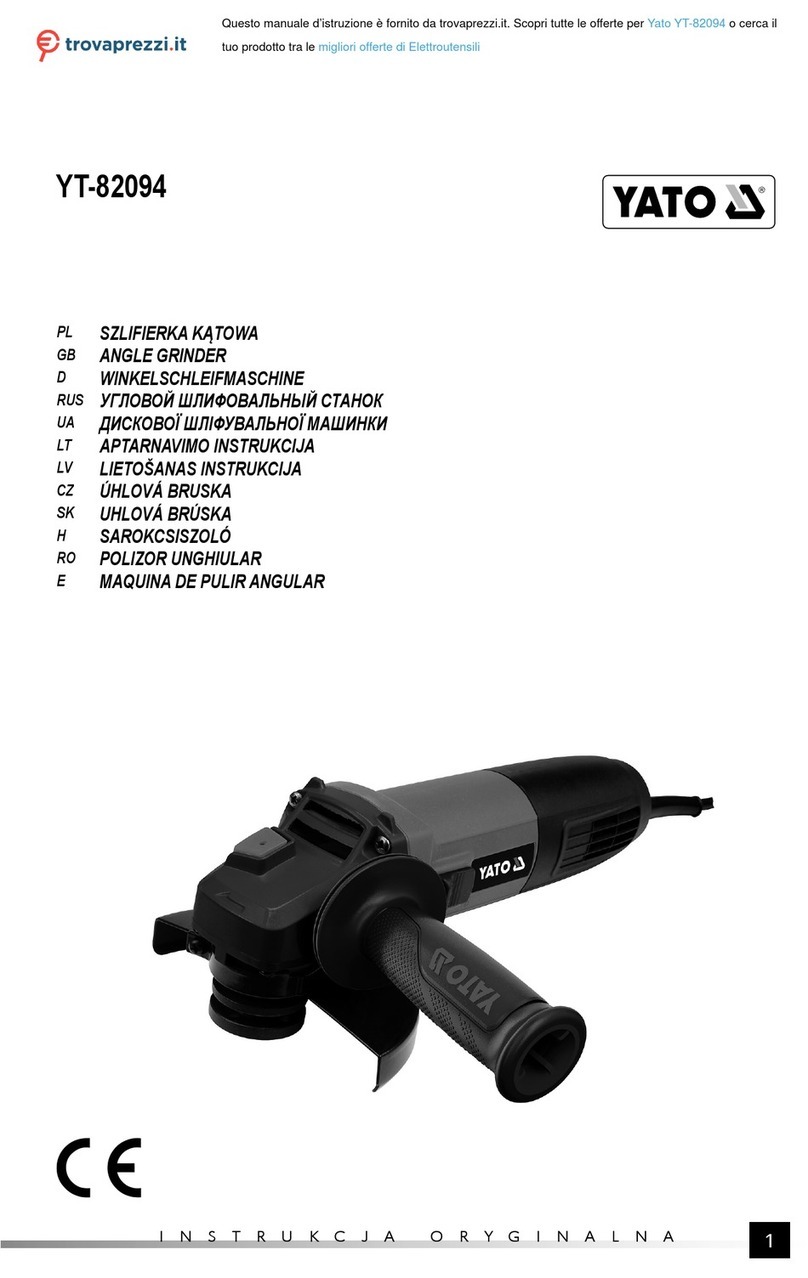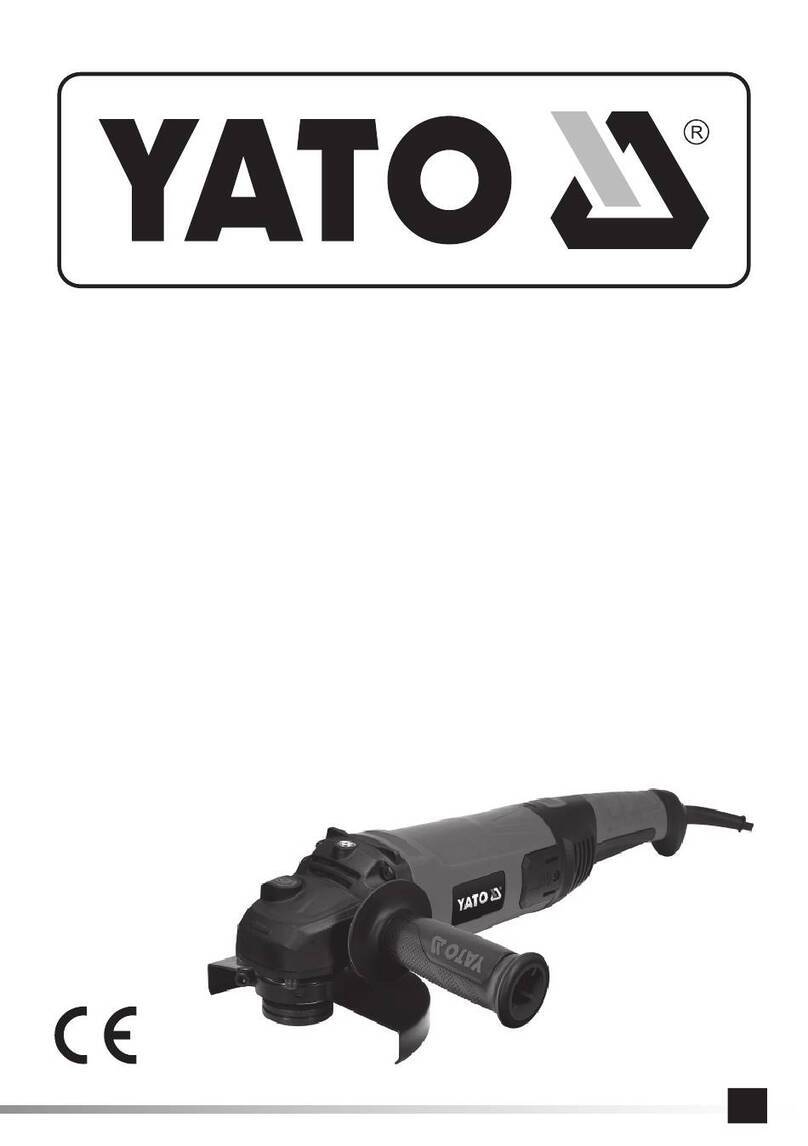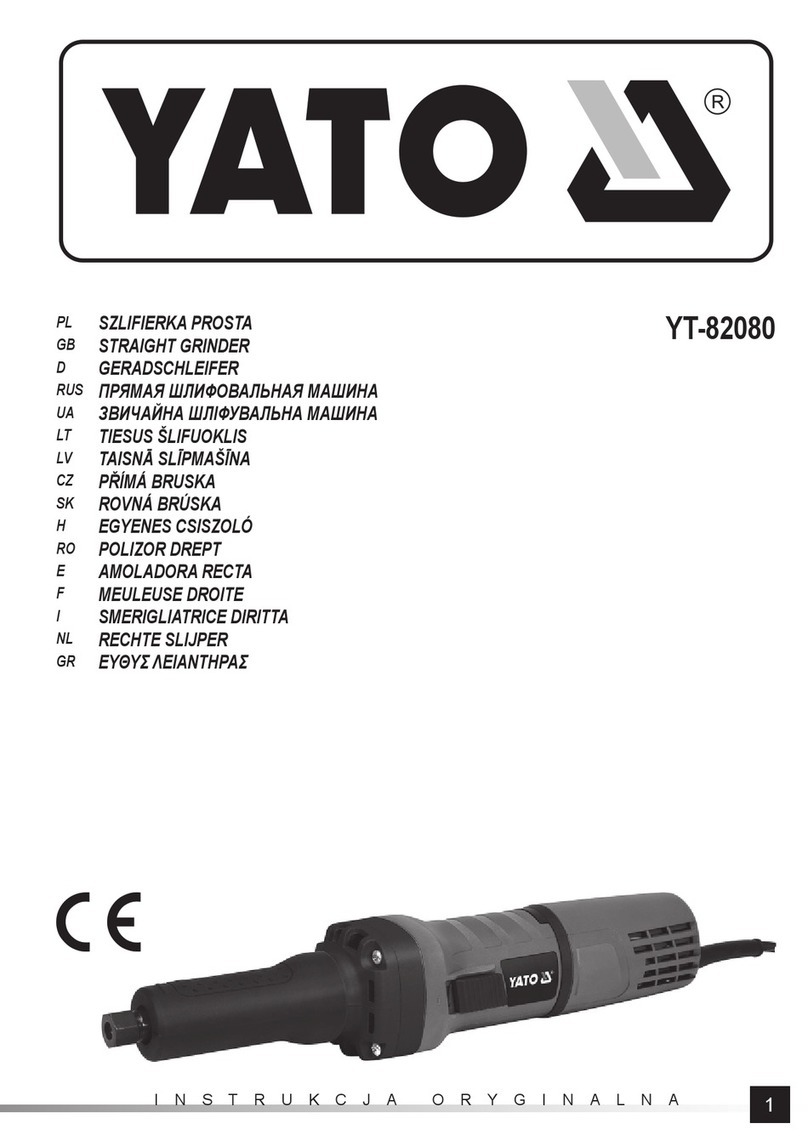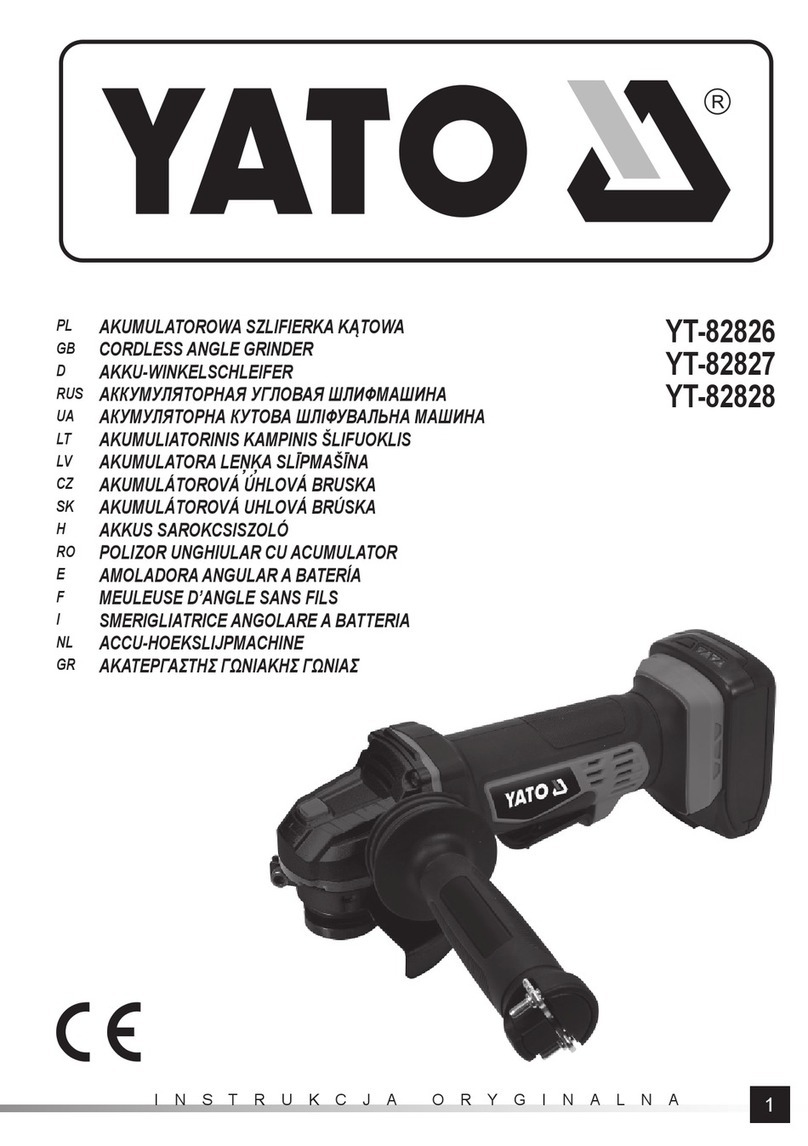
INSTRUKCJA ORYGINALNA 5
PL EN DE RU UA LT LV CZ SK HU RO ES FR IT NL GR BG PT HR AR
Ten symbol informuje o zakazie umieszczania zużytego sprzętu elektrycznego i elektronicznego (w tym baterii i akumulatorów) łącznie z innymi odpadami. Zużyty sprzęt
powinien byćzbierany selektywnie i przekazany do punktu zbierania w celu zapewnienia jego recyklingu i odzysku, aby ograniczaćilość odpadów oraz zmniejszyćstopnień
wykorzystania zasobów naturalnych. Niekontrolowane uwalnianie składników niebezpiecznych zawartych w sprzęcie elektrycznym i elektronicznym może stanowićzagroże-
nie dla zdrowia ludzkiego oraz powodowaćnegatywne zmiany w środowisku naturalnym. Gospodarstwo domowe pełni ważnąrolęw przyczynianiu siędo ponownego użycia
i odzysku, w tym recyklingu zużytego sprzętu. Więcej informacji o właściwych metodach recyklingu można uzyskaću władz lokalnych lub sprzedawcy.
Dieses Symbol weist darauf hin, dass Elektro- und Elektronik-Altgeräte (einschließlich Batterien und Akkumulatoren) nicht zusammen mit anderen Abfällen entsorgt werden
dürfen. Altgeräte sollten getrennt gesammelt und bei einer Sammelstelle abgegeben werden, um deren Recycling und Verwertung zu gewährleisten und so die Abfallmenge
und die Nutzung natürlicher Ressourcen zu reduzieren. Die unkontrollierte Freisetzung gefährlicher Stoffe, die in Elektro- und Elektronikgeräten enthalten sind, kann eine
Gefahr für die menschliche Gesundheit darstellen und negative Auswirkungen auf die Umwelt haben. Der Haushalt spielt eine wichtige Rolle bei der Wiederverwendung
und Verwertung, einschließlich des Recyclings von Altgeräten. Weitere Informationen zu den geeigneten Recyclingverfahren erhalten Sie bei den örtlichen Behörden oder
Ihrem Händler.
Этот символ информирует озапрете помещать изношенное электрическое иэлектронное оборудование (втом числе батареи иаккумуляторы) вместе сдругими
отходами. Изношенное оборудование должно собираться селективно ипередаваться вточку сбора, чтобы обеспечить его переработку иутилизацию, для того,
чтобы ограничить количество отходов, иуменьшить использование природных ресурсов. Неконтролируемый выброс опасных веществ, содержащихся вэлектри-
ческом иэлектронном оборудовании, может представлять угрозу для здоровья человека, иприводить кнегативным изменениям вокружающей среде. Домашнее
хозяйство играет важную роль при повторном использовании иутилизации, втом числе, утилизации изношенного оборудования. Подробную информацию о
правильных методах утилизации можно получить уместных властей или упродавца.
This symbol indicates that waste electrical and electronic equipment (including batteries and storage cells) cannot be disposed of with other types of waste. Waste equipment
should be collected and handed over separately to a collection point for recycling and recovery, in order to reduce the amount of waste and the use of natural resources. Un-
controlled release of hazardous components contained in electrical and electronic equipment may pose a risk to human health and have adverse effects for the environment.
The household plays an important role in contributing to reuse and recovery, including recycling of waste equipment. For more information about the appropriate recycling
methods, contact your local authority or retailer.
Цей символ повідомляє про заборону розміщення відходів електричного та електронного обладнання (втому числі акумуляторів), утому числі зіншими відходами.
Відпрацьоване обладнання повинно бути вибірково зібрано іпередано впункт збору для забезпечення його переробки івідновлення, щоб зменшити кількість відхо-
дів ізменшити ступінь використання природних ресурсів. Неконтрольоване вивільнення небезпечних компонентів, що містяться велектричному та електронному
обладнанні, може представляти небезпеку для здоров’ялюдини івикликати негативні зміни внавколишньому середовищі. Господарство відіграє важливу роль у
розвитку повторного використання та відновлення, включаючи утилізацію використаного обладнання. Більш детальну інформацію про правильні методи утилізації
можна отримати умісцевої влади або продавця.
Šis simbolis rodo, kad draudžiama išmesti panaudotąelektrinęir elektroninęįrangą(įskaitant baterijas ir akumuliatorius) kartu su kitomis atliekomis. Naudota įranga turėtų
būti renkama atskirai ir siunčiama įsurinkimo punktą, kad būtųužtikrintas jos perdirbimas ir utilizavimas, siekiant sumažinti atliekas ir sumažinti gamtos ištekliųnaudojimą.
Nekontroliuojamas pavojingųkomponentų, esančiųelektros ir elektroninėje įrangoje, išsiskyrimas gali kelti pavojųžmoniųsveikatai ir sukelti neigiamus natūralios aplinkos
pokyčius. Namųūkis vaidina svarbųvaidmenįprisidedant prie pakartotinio įrenginiųnaudojimo ir utilizavimo, įskaitant perdirbimą. Norėdami gauti daugiau informacijos apie
tinkamus perdirbimo būdus, susisiekite su savo vietos valdžios institucijomis ar pardavėju.
Šīs simbols informēpar aizliegumu izmest elektrisko un elektronisko iekārtu atkritumus (tostarp baterijas un akumulatorus) kopāar citiem atkritumiem. Nolietotas iekārtas ir
jāsavāc atsevišķi un jānodod savākšanas punktāar mērķi nodrošināt atkritumu otrreizējo pārstrādi un reģenerāciju, lai ierobežotu to apjomu un samazinātu dabas resursu
izmantošanas līmeni. Elektriskajās un elektroniskajās iekārtās ietverto bīstamo sastāvdaļu nekontrolēta izdalīšanās var radīt cilvēku veselības apdraudējumu un izraisīt
negatīvas izmaiņas apkārtējāvidē. Mājsaimniecība pilda svarīgu lomu otrreizējās izmantošanas un reģenerācijas, tostarp nolietoto iekārtu pārstrādes veicināšanā. Vairāk
informācijas par atbilstošām otrreizējās pārstrādes metodēm var saņemt pie vietējo varas iestāžu pārstāvjiem vai pārdevēja.
Tento symbol informuje, že je zakázáno likvidovat použité elektrické a elektronické zařízení (včetněbaterií a akumulátorů) společněs jiným odpadem. Použité zařízení by
mělo být shromažďováno selektivněa odesíláno na sběrné místo, aby byla zajištěna jeho recyklace a využití, aby se snížilo množství odpadu a snížil stupeňvyužívání
přírodních zdrojů. Nekontrolované uvolňování nebezpečných složek obsažených v elektrických a elektronických zařízeních může představovat hrozbu pro lidské zdraví a
způsobit negativní změny v přírodním prostředí. Domácnost hraje důležitou roli při přispívání k opětovnému použití a využití, včetněrecyklace použitého zařízení. Další
informace o vhodných způsobech recyklace Vám poskytne místní úřad nebo prodejce.
Tento symbol informuje o zákaze vyhadzovania opotrebovaných elektrických a elektronických zariadení (vrátane batérií a akumulátorov) do komunálneho (netriedeného)
odpadu. Opotrebované zariadenia musia byťseparované a odovzdané do príslušných zberných miest, aby mohli byťnáležite recyklované, čím sa znižuje množstvo odpadov
a zmenšuje využívanie prírodných zdrojov. Nekontrolované uvoľňovanie nebezpečných látok, ktoré sú v elektrických a elektronických zariadeniach, môže ohrozovaťľudské
zdravie a maťnegatívny dopad na životné prostredie. Každá domácnosťmá dôležitú úlohu v procese opätovného použitia a opätovného získavania surovín, vrátane recy-
klácie, z opotrebovaných zariadení, Bližšie informácie o správnych metódach recyklácie vám poskytne miestna samospráva alebo predajca.
Ez a szimbólum arra hívja fel a figyelmet, hogy tilos az elhasznált elektromos és elektronikus készüléket (többek között elemeket és akkumulátorokat) egyéb hulladékokkal
együtt kidobni. Az elhasznált készüléket szelektíven gyűjtse és a hulladék mennyiségének, valamint a természetes erőforrások felhasználásának csökkentése érdekében
adja le a megfelelőgyűjtőpontban újrafeldolgozás és újrahasznosítás céljából. Az elektromos és elektronikus készülékben található veszélyes összetevők ellenőrizetlen
kibocsátása veszélyt jelenthet az emberi egészségre és negatív változásokat okozhat a természetes környezetben. A háztartások fontos szerepet töltenek be az elhasznált
készülék újrafeldolgozásában és újrahasznosításában. Az újrahasznosítás megfelelőmódjaival kapcsolatos további információkat a helyi hatóságoktól vagy a termék
értékesítőjétől szerezhet.
Acest simbol indicăfaptul cădeșeurile de echipamente electrice și electronice (inclusiv baterii și acumulatori) nu pot fieliminate împreunăcu alte tipuri de deșeuri. Deșeurile
de echipamente trebuie colectate și predate separat la un punct de colectare în vederea reciclării și recuperării, pentru a reduce cantitatea de deșeuri și consumul de resurse
naturale. Eliberarea necontrolatăa componentelor periculoase conținute în echipamentele electrice și electronice poate prezenta un risc pentru sănătatea oamenilor și are
efect advers asupra mediului. Gospodăriile joacăun rol important prin contribuția lor la reutilizare și recuperare, inclusiv reciclarea deșeurilor de echipamente. Pentru mai
multe informații în legăturăcu metodele de reciclare adecvate, contactați autoritățile locale sau distribuitorul dumneavoastră.
Este símbolo indica que los residuos de aparatos eléctricos y electrónicos (incluidas las pilas y acumuladores) no pueden eliminarse junto con otros residuos. Los aparatos
usados deben recogerse por separado y entregarse a un punto de recogida para garantizar su reciclado y recuperación a fin de reducir la cantidad de residuos y el uso de
los recursos naturales. La liberación incontrolada de componentes peligrosos contenidos en los aparatos eléctricos y electrónicos puede suponer un riesgo para la salud
humana y causar efectos adversos en el medio ambiente. El hogar desempeña un papel importante en la contribución a la reutilización y recuperación, incluido el reciclado
de los residuos de aparatos. Para obtener más información sobre los métodos de reciclaje adecuados, póngase en contacto con su autoridad local o distribuidor.















































